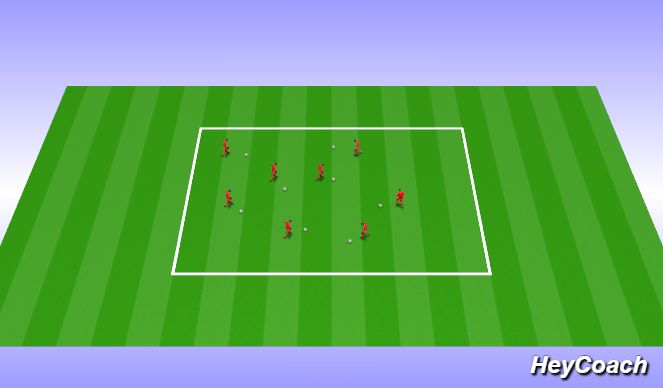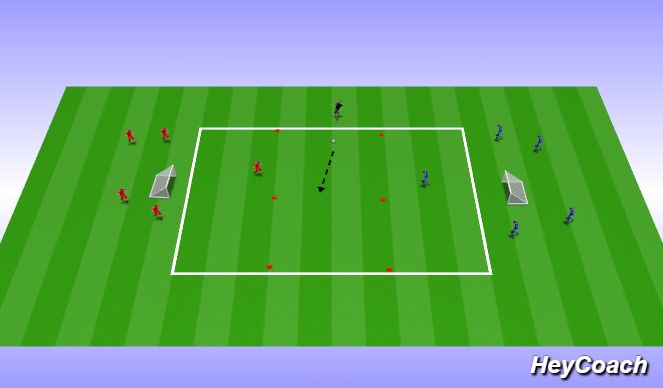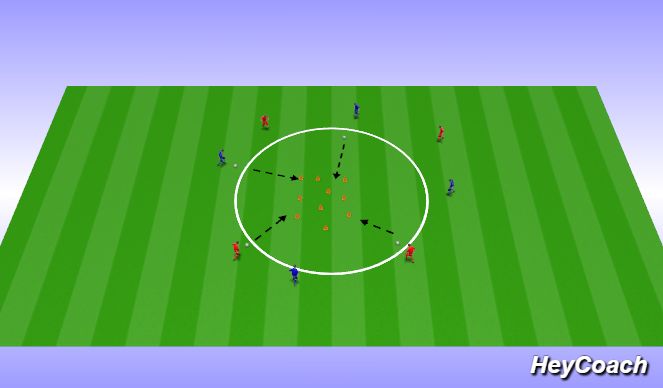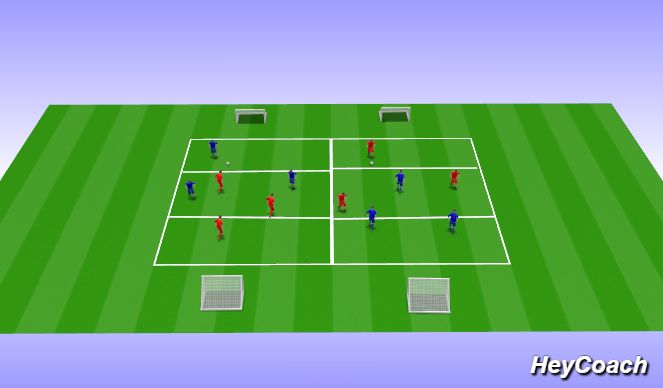
Organization:
Mark a square approximately 15 yards by 15 yards, depending on numbers.
Each player should have a ball.
If not, use the "Change Soccer" principle: half the players inside the square, each with a ball, the remaining half outside the square, without a ball. Trade places when coach shouts "Change!"
Players can dribble around anywhere within the square, but should not walk.
Three instructions are given to the players inside the square:
"STOP" - Put foot on top of ball quickly and freeze like a statue.
"GO" - Move right or left with the ball, fast, for three or four yards.
"TURN" - Quickly turn 180 degrees with the ball, moving three or four yards
Teaching:
Encourage players to keep the ball close to their feet.
Occasionally insist on using left foot only or right foot only.
See how many different ways they can turn with the ball.
To avoid giving players too much information at once, introduce instructions one at a time and incorporate practice time between.
Later, incorporate your own ideas.
Target:
Stay in the area with the ball and make no contact with other players or other balls

Organization:
Use the 3-a-side Micro Soccer® field.
Widen the goals.
All players start on goal line.
Each player on each team is given a number.
Coach calls out number (e.g., "Three!") and rolls the ball into play.
The two opposing number "Three" players leave the goal line immediately and compete for possession for a maximum of 20 seconds.
Coach keeps some balls by him and so can roll another ball into play if one is kicked out.
Call two numbers - "One!" and "Three!" - to create 2 vs 2.
Remaining players defend goal without using hands and they must stay within one yard of goal line. Goals only count below knee height.
If one player fails to respond to the number, a penalty - a free shot at open goal from half-way line - is called to keep players on their toes and make it fun.
Teaching:
If organization is working, let them play, enjoy the game and learn by trial and error.
Encourage attackers to take on opponents and Go for the Goal!
Defenders should stay on their feet as long as possible, rather than slide-tackling.
Defenders must try to run back and recover even when beaten.
Target:
To outscore opposing team.

Objective:
A fun center circle practice.
Developing accurate kicking.
Organization:
Mark a circle having a center mark (line intersection; a coin; a scratched "X").
A center circle works well, but may be too big for young players.
5-yard radius for 6-year olds; 6-yard for 7-year olds, etc.
Use marker disks to make a circle.
From center spot pace out the radius by going North, South, East and West. Then fill in the rest of the circle. Each player on one side of the circle has a partner directly opposite.
If there is an odd number the coach joins in. Each pair has one ball between them.
One player passes the ball towards his or her partner, but tries to knock over a cone in the center circle. The partner retrieves the ball and returns the pass through the center circle, again trying to kick over a cone. The ball must be passed from outside the circle. The game is stopped when all cones are knocked down.
Teaching:
Encourage the players to use pace as well as accuracy of pass. Suggest they continue to kick towards the ball even after they have actually kicked (follow through).
Encourage them to approach the ball at a slight angle to the direction they are kicking (45 degrees).
Target:
The coach uses a stopwatch to set the "team" record of knocking all cones down. Later, winners are the pair to first knock over the cones 5 (6, 8,10) times.

Objective:
To create a Jamboree atmosphere.
Children just play without any coaching
Organization:
Any number of players above 11 can create a Jamboree atmosphere. Consider joining up with another team who practice at the same time. If less than 12 players, make up three teams (of 3 or 4 players). Have a second activity area (such as the Circle Game) as one team waits their turn to play.
With 12 or more put in two fields or more, depending on numbers. With more than one field synchronize the play. The time-keeper starts the game for everyone with a long whistle, and signals the end of the quarters and the end of the games. One long blast signals the start of play.
A short blast signals the end of each quarter.
After the end of each quarter the substitutions/rotations take place and the game is recommenced as quickly as possible without a signal from the time-keeper.
Restart with an indirect free kick from the part of the field where the period ended with the kick taken by the team that was in possession.
A short blast, followed by a long blast signifies the end of the game at the conclusion of the fourth quarter.
Play 4-periods of two minutes. Try not to have more than 4 players on a team.
With 4, at the end of each period, the sub becomes the goalkeeper, the goalkeeper moves out onto the field. One field player comes off. After 4-periods each player will have played 3 quarters - once in goal and twice on the field. Use the same principle with 3 players or 5 players (equal time in goal and on the field). Teams work on a Round-Robin format.
Teaching:
Coaches have to work hard to say … nothing!
Target:
To enjoy the sheer fun of unadulterated soccer with plenty of opportunities to get touches of the ball and score goals.